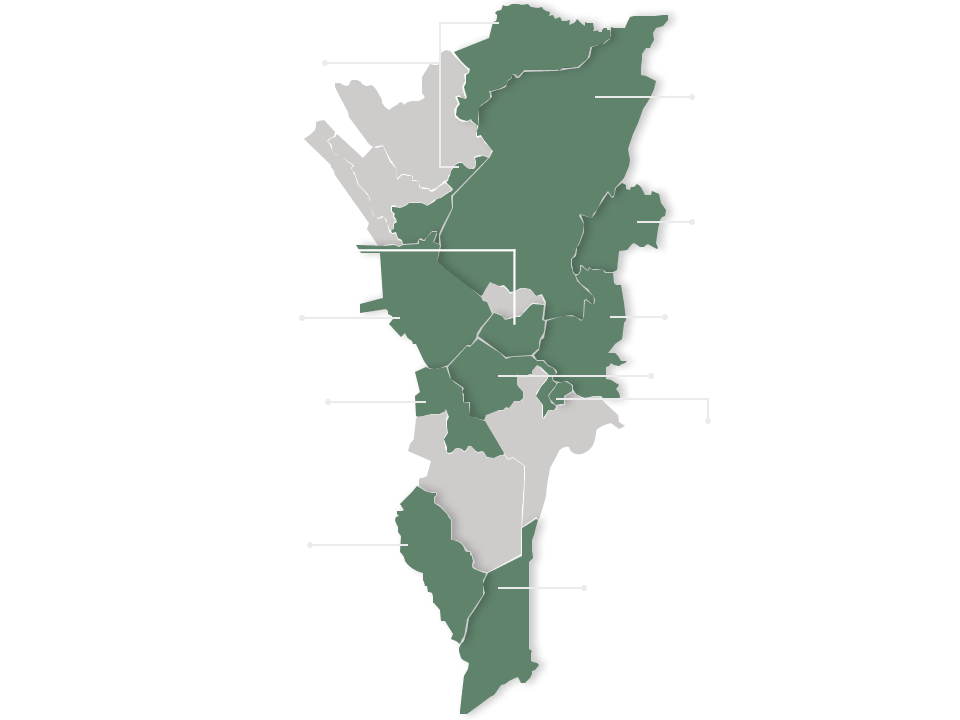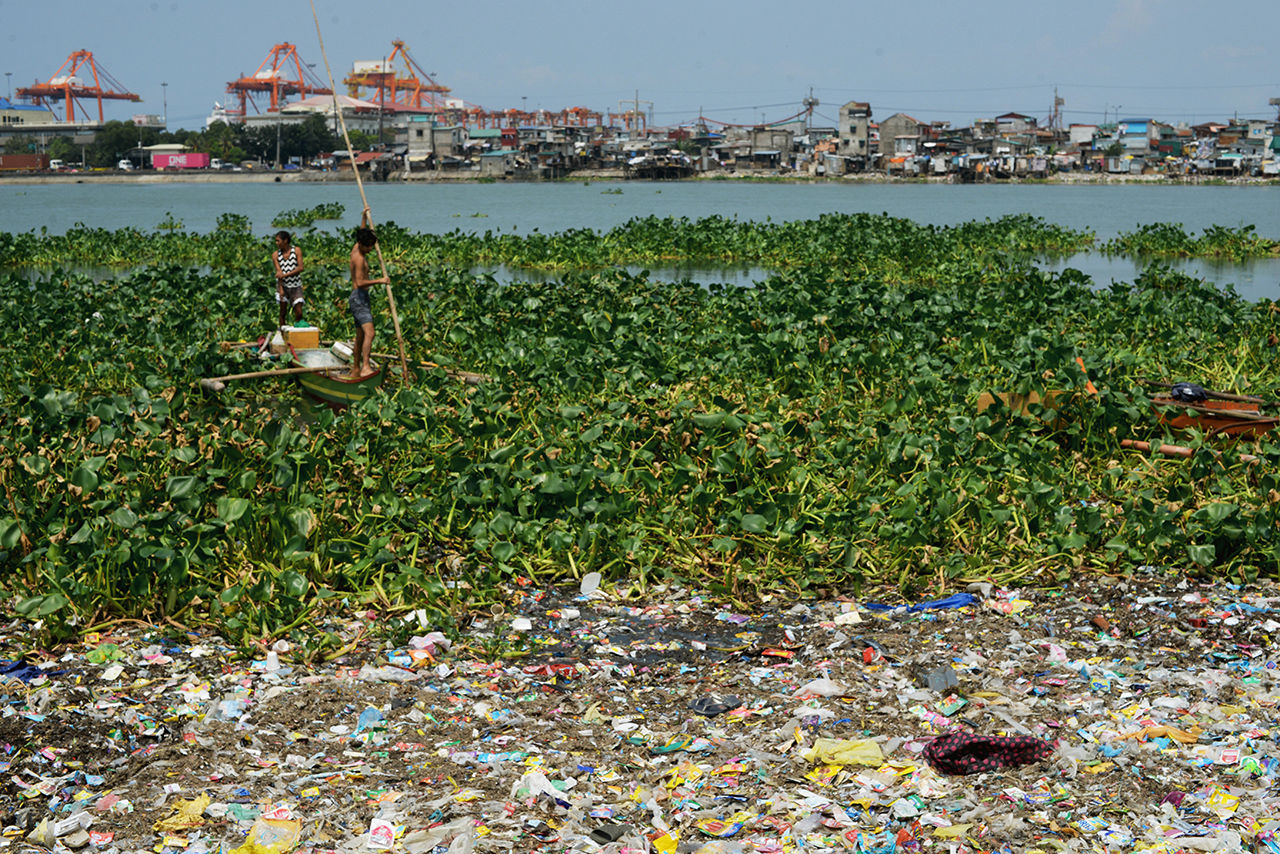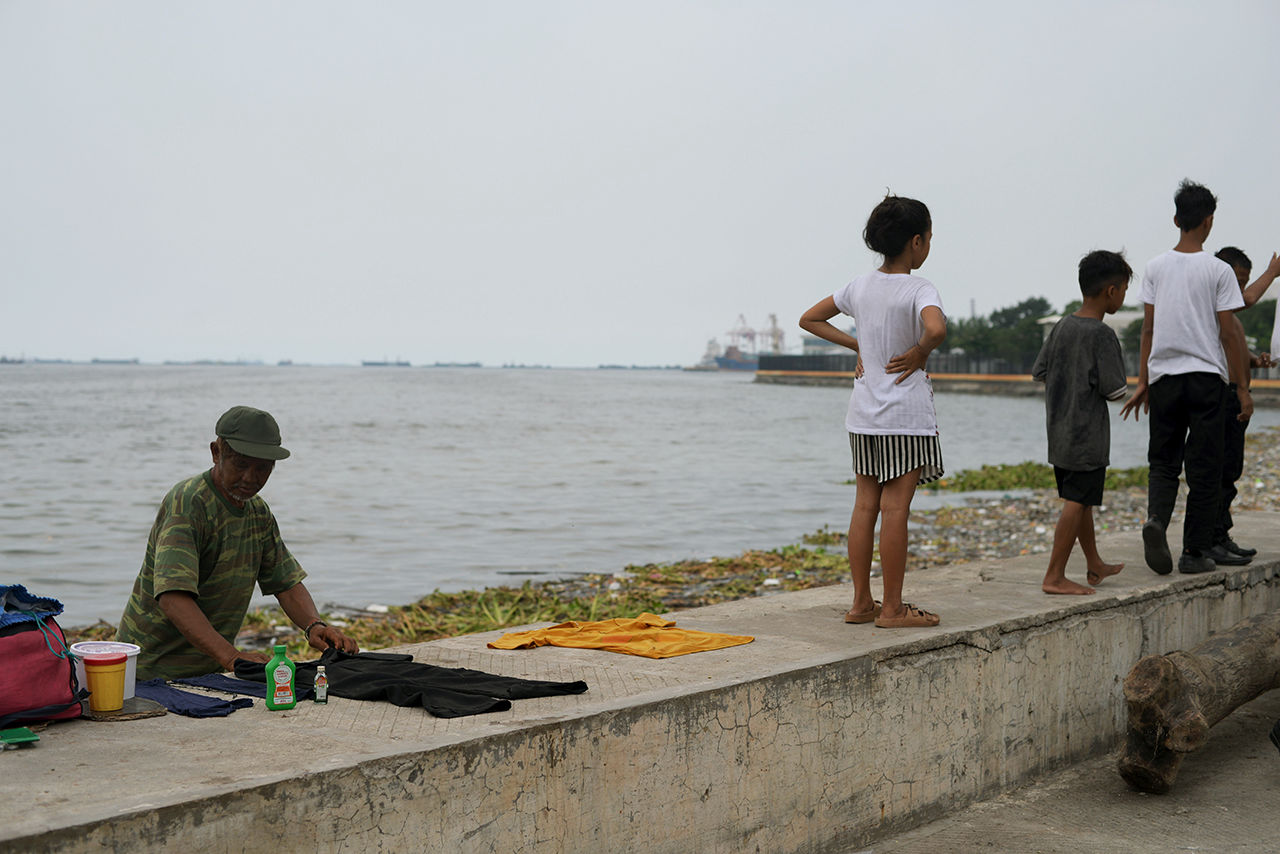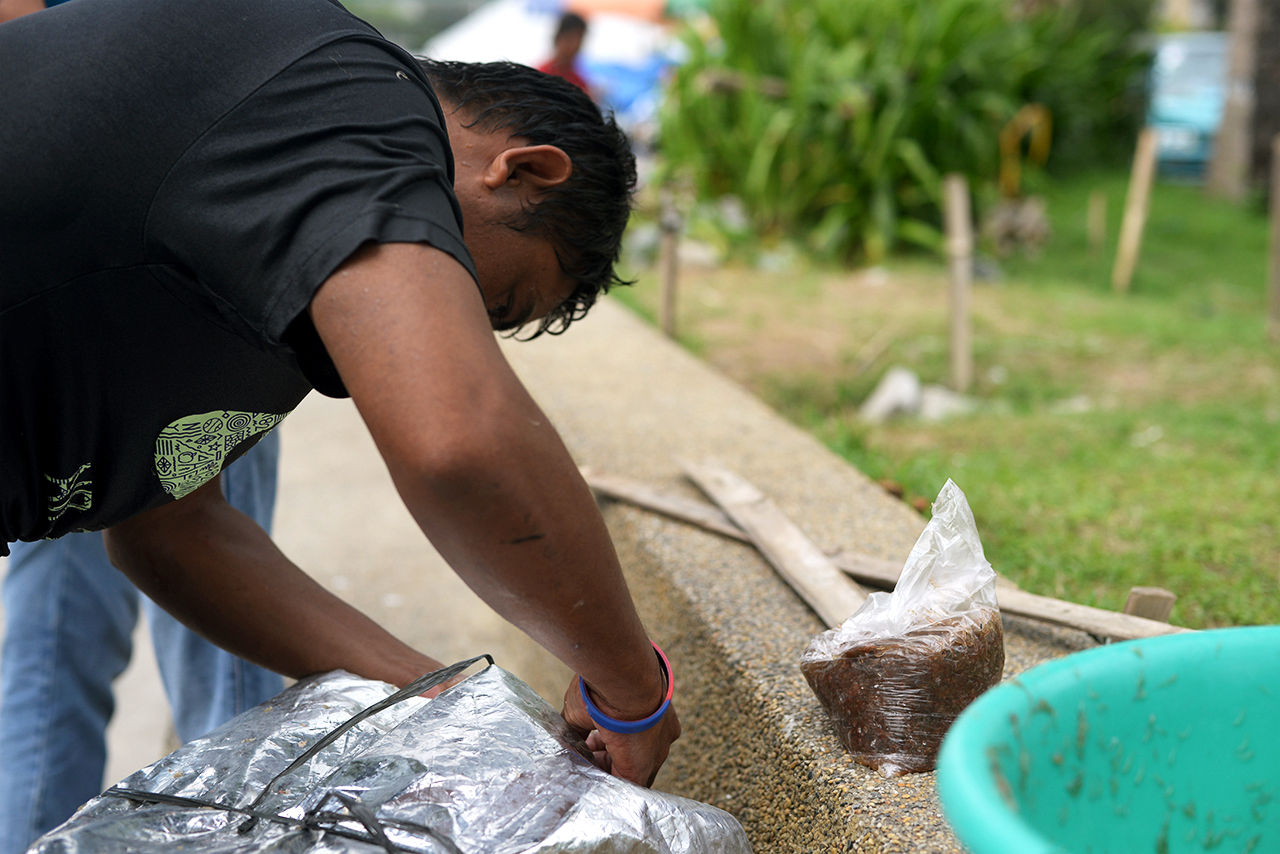Plastic is pervasive in the Philippines — not just in our environment, but also in our economy. The pollution problem it causes has had dire effects on our seas and our shores, but now it is also affecting our food and our bodies.
By JESSICA BARTOLOME, GMA News
Design by Jannielyn Ann Bigtas
November 19, 2018
IN THE AFTERMATH of monsoon-enhanced rains one August weekend, Manila’s Baywalk was a sea of trash.
Discarded food packaging, water bottles, and plastic bags littered Roxas Boulevard, tossed there by the violent waves of Manila Bay. Ten trucks of garbage were collected during the first three days of the cleanup alone, and it took a few more days to completely clear the area.
It was a picture of nature taking revenge, coughing back up garbage carelessly thrown away by humans.
Around 56,000 cubic meters of trash are produced in the National Capital Region everyday in 2018, according to data from the Metropolitan Manila Development Authority (MMDA). This is an increase from the 54,000 cubic meters recorded to have been produced daily last year.
The MMDA said it takes 1,200 to 1,500 trips for trucks to transport the trash every day to sanitary landfills in San Mateo and Rodriguez in Rizal, as well as one in Navotas. Thirty-two percent of the trash, it found, were non-biodegradable.
And that would only be the trash that actually makes it to landfills. So much more end up being thrown away carelessly, making their way down waterways, rivers, and eventually to the sea.
On September 22, the MMDA held a coastal cleanup in Manila Bay, after Typhoon Ompong (international name: Mangkhut) triggered violent waves that threw back trash along Roxas Boulevard. Volunteers dug through the slough that piled up at the shores as the MMDA carted off truck after truck of garbage.
What the volunteers found: plastic.
During the cleanup, the volunteers picked up 256,429 pieces of inorganic waste, of which 187,851 were pieces of plastic — most notably snack bags, juice pouches, shelf-stable packaging, and one-time-use personal care sachets.
THAT PLASTIC WOULD BE THE MAIN CULPRIT for all that garbage is no surprise to Joseph Aguirre. From his house overlooking Manila Bay in Baseco in Tondo, the 59-year-old has been a witness to garbage washing up on the shores every time strong winds and rains hit the Philippines.
Joseph has lived in Baseco for the past 23 years. Like most residents there, he used to live in a shanty, before eventually getting awarded a house in Gawad Kalinga’s Baseco Village.
In stark contrast to the cramped and dense population that the community is known for, the area where Joseph lives is airy and spacious. The view would be wonderful if it weren’t dotted with trash, and the breeze would be refreshing if it didn’t bring with it the smell of garbage.
“Plastic world na nga tayo eh,” he tells GMA News Online.
(“We already live in a plastic world.”)
Joseph, of all people, would know. He runs a sari-sari store in what used to be a canteen, selling chips, snacks, shampoos, and soft drinks to his neighbors. His is not the only sari-sari store in that strip of road in the bayside, much less in the entire village, or the entire Baseco community.
The fact that Joseph’s family found running a sari-sari store more sustainable than a canteen is a hint at how sachets are embedded in the Filipino culture, long before its effects on the environment became glaringly obvious.
Every day, Joseph’s neighbors buy plastic sachets of shampoo and conditioner. Children love to buy snacks — chips, chocolates, candies — all wrapped in plastic.
Having a front row seat to the plastic pollution in the country makes Joseph wish there were other options available for them. He said he can barely walk along the street without encountering trash.
The irony of having contributed to plastic waste is not lost on him.
“Ang plastic talaga ang sumisira. Makikita naman 'yan, sa tabing-ilog, sa dagat, kahit saang lugar may plastic eh. So talagang nagpapa-pollute 'yan,” he says.
( “Plastic does the worst damage. You could sea it by the rivers, the shore, everywhere there's plastic, and it pollutes.”)
But with the sari-sari store making up the bulk of his earnings, Joseph has little choice but to use plastic. Like everyone else in Baseco, he is struggling to bring in money to get them through day after day.
The Metropolitan Manila Development Authority (MMDA) is mandated, among other things, to manage solid waste disposal in the National Capital Region (NCR). It is responsible for hauling off piles of garbage to landfills, and initiates cleanups in waterways and in Manila Bay. MMDA spokesperson Assistant Secretary Celine Pialago said the worsening problem is due to the growing population and the public’s lack of awareness about solid waste management.
Source: Metropolitan Manila Development Authority
PLASTIC POLLUTION IS BAD ENOUGH that several local government units have seen it necessary to pass ordinances regulating, or even outright banning, plastics packaging in the past few years. Eleven out of the 17 cities and municipality in Metro Manila have existing ordinances regulating the use of plastics and polyesterine foam (styrofoam and Styropor).
But for environmental groups, the implementation leaves much to be desired.
For instance, Manila Mayor Joseph Estrada often orders clean-up drives at Manila Bay, but environmental groups note that Ordinance No. 8282, signed by his predecessor Alfredo Lim in 2012, has since been dormant.
Ecowaste Coalition, a member of the Break Free From Plastic campaign, last year urged Estrada to enforce the ordinance, which bans the use of polystyrene for food and produce containers; bans plastic bags for dry goods; and regulates the use of plastic bags for wet goods.
Von Hernandez, a global coordinator for Break Free From Plastic, says local governments don't do the work necessary to implement the law to the letter, which usually requires organizing and educating communities. Most local governments, he says, focus on garbage collection instead.
The MMDA, which is tasked to manage solid waste disposal in NCR, acknowledges that much could be done to educate the public about plastic pollution. Assistant Secretary Celine Pialago, the MMDA's spokesperson, attributes the worsening problem to the growing population and the public’s lack of awareness about solid waste management.
Hernandez, meanwhile, says policy regarding plastic should be made at the national level.
There are bills that have been filed in both chambers of Congress seeking some regulation on single-use plastics.
House Bill 7903, entitled “An Act Providing for the Phase-out of Single-Use Plastic Products in the Country," seeks to ban materials “made wholly or partly from plastic and that is not conceived, designed or placed on the market to accomplish, within its life span, multiple trips or rotation by being returned to the producer for refill or reused for the same purpose for which it was conceived such as, but not limited to, plastic straws, plastic cups and lids, shrink wrap and other packaging for products.”
Senate Bill No. 1866, otherwise known as “The Plastic Straw and Stirrer Ban of 2018,” seeks to ban the use of plastic straws and stirrers in restaurants and other establishments. It prohibits food service establishments and/or other service establishments that serve beverages from offering consumers any single-use beverage straw and stirrer made of plastic or any other non-biodegradable material.
The measure also mandates food service establishments and other service providers occupying fixed spaces, such as sari-sari stores, to prominently display signs informing their customers of their “no plastic straw and stirrer” policy.
“That’s the kind of leadership we expect from governments, whether the national or local level, to go after problematic and unnecessary plastics, things that we really don't need,” Hernandez says.
Each bill, however, remains at the committee level at their respective chambers.

BUT WHILE THERE ARE MANY FACTORS that cause plastic pollution, such as lack of discipline and poor implementation of environmental laws, advocates say the role of corporations is often overlooked.
“Greenpeace is very serious in putting the accountability of corporations in this problem because they’re the ones promoting. That’s why we keep hammering that message that in order to solve the plastic pollution problem, you have to cut it at source,” says Abigail Aguilar, a campaigner for the organization.
The group regularly conducts coastal cleanups, and Aguilar is heartened by the increasing turnout of volunteers to their events. But given the magnitude of the problem, Aguilar thinks cleanups are akin to fruitlessly mopping the bathroom floor when the toilet is flooding.
“Last year, we tried to clean up Freedom Island, it’s in Las Piñas, Parañaque. We’d clean up a whole area... and after just a few hours... it’s back,” she says.
“It never ends. The only solution to that is to cut the problem at source.”
This is what Break Free From Plastic, along with the independent environmental groups partnered with it, wants to do: to identify the world’s top ocean polluters and hold them accountable.
Hernandez, the Break Free From Plastic coordinator, notes how single-use plastics produced by corporations are designed to be thrown away.
“It is their continued reliance and production of throwaway plastic that’s really causing the problem, because those products are designed to be wasted,” he says. “They cannot be recycled, they cannot be composted. They are really designed to go straight to the landfill or they end up in the oceans.”
World Wide Fund for Nature (WWF) Philippines, which recently launched the #AyokoNgPlastic movement, saw the same issue after it studied consumer behavior.
“A study would show the average use of the single-use plastic is seven minutes. After seven minutes they do away with that,” WWF Philippines president Joel Palma says. “And then it takes more than 400 years to eventually degenerate.”
AFTER ITS BRAND AUDIT LAST YEAR, Greenpeace found that international brands headquartered in Western countries are driving the use of single-use plastics in the Philippines and other developing countries.
Nestle, Unilever, PT Torabika, Universal Robina Corporation, Procter & Gamble, and Monde Nissin were on the list of brands found during the cleanup and audit at Freedom Island in Parañaque last year.
The latest audits — conducted along Pasig River on September 17 and Roxas Boulevard on September 22 — shows brands from JBC Food Corporation, Mondelez International, and Oishi among the top producers of plastic wastes found. In separate statements to GMA News Online, Unilever Philippines and Universal Robina Corporation said they recognize the shared responsibility of addressing the issue of plastic pollution and vowed they were taking measures to tackle the issue.
They said they have teamed up with the Philippine Alliance for Recycling and Materials Sustainability with the goal of achieving a Zero Waste Philippines.
Other consumer goods companies working with PARMS include Liwayway Marketing Corporation (which produces Oishi), Monde Nissin Corp., Nestle Philippines Inc., Procter & Gamble Philippines, and PT Torabika.

TO HEAR CONSUMER-GOODS CORPORATIONS TELL IT, the plastic packaging for their products is a pro-poor solution, a way of distributing to the masses safely and inexpensively.
Everything from snacks, meal ingredients, grooming, and household products have a sachet version of its packaging, accessible from the ever-present sari-sari stores to supermarkets.
Crispian Lao, the president of PARMS, says the sachet system in the country has made it possible for the lower classes to afford branded products.
“The ‘tingi’ system is really unique and very popular in the Philippines. That’s the amount the consumers can afford at a daily basis,” he said.
He explains how plastic packaging is made thinner and lighter, making it affordable even in small increments, but also making its disposal more challenging.
Lao also claims that single-use packaging actually serves as a safeguard for sanitation and preservation of the products that Filipinos consume — which is why his group is against any ban on single-use plastic packaging.
“Those single-use packages, when you look at the sector it was initially designed for, it allows now our Class CD market, the poorer, lower income-class access to safe, branded products that they couldn’t have access to before,” he says.
“There are health issues especially if they’re food containing materials… we are a high humid area, bacterial contamination is always there. [Aside from] the sanitation of food, it also preserves our food for a longer time,” he adds.
Greenpeace Philippines, however, isn’t buying that explanation.
“Not many options are given to us Filipinos. We beg to disagree and debunk the belief that sachets are pro-poor, or they only produce it for the lower income class families or citizens, because even middle-class Filipinos would buy them. Why? Because we are not given options,” Aguilar says.
WWF Philippines also doesn’t see single-use as completely necessary.
“We’ve always been looking at convenience but at the end of the day this convenience is [taking a toll on] us,” WWF Philippines president Joel Palma says. “We didn't have [single-use plastics] 30, 40 years ago. It’s not really a matter of life or death. We can do it again.”
— Von Hernandez, Break Free From Plastic Global Coordinator, on single-use plastic packaging
SWITCHING FROM PLASTICS to alternative materials is an option that Lao, the PARMS executive, acknowledges, but he is quick to add that this cannot be achieved easily.
“On the short term could this be possible? I don’t think so. We have to establish a system where it protects the consumer just the same,” he says.
Lao says the problem must be dealt with “where we can deal with it first” and “not where you can’t touch it already.”
“I think single-use packaging should be minimized in institutions. You don’t need your packets or sachets to serve coffee in an office, or a restaurant, in a school, in a resort. Establishments like that can control the quality,” he says.
“I think these are some of the areas we have to start with and eventually look at other options,” he adds.
PARMS and its partners have the same mindset: that there is no need to completely eradicate plastics, but instead find ways to limit the leakage into the environment.
“Given that we have a situation where there’s lack of infrastructure for waste management in the Philippines, and a lack of treatment facilities, it’s really important now to find solutions for all of these problems,” he says.
PARMS is looking to create value for single-use plastics so that they do not turn into waste. To achieve this, it is establishing a recycling facility in Parañaque that will help create products made from plastics that will be marketed to the public. That way, junk collectors will have incentive to pick up low-value plastics because they have a facility they can sell it to.
But advocates are skeptical about solutions put forward by the industry.
“Nobody bothers to collect them because they have no value, and now PARMS is trying to say that they have to attach some value to the throwaway plastics? And then they can recycle or downcycle it into other products,” Hernandez says.
“This is dubious because of the track record of industry, and I’m talking about a 70-year track record,” he adds.
Citing a study conducted by the University of Georgia, Hernandez says that since plastics went into massive global production in the 1950s, less than 10 percent of them have been recycled. Most of the plastics actually ended up in landfills or the oceans.
Twelve percent of the plastics were incinerated, which Hernandez says is simply a fancy term to say that the pollution was transferred from land to air.
“For years they’ve duped the public into thinking that we can recycle our way out of this crisis,” he says. “(We're thinking) this is recyclable, all we need to do is put it in the right bin. It’s not actually being recycled.”
At the end of the day, it’s all about making companies accountable for their role in plastic pollution.
“For a long time, companies have been trying to portray this issue as an issue about littering, about consumer responsibility and individual behavior,” Hernandez says. “They try to sponsor all kinds of clean-ups, or clean and green campaigns... that deflects attention from their role.”
As for the saying, “reduce, reuse, recycle?” Not so much on the “recycle,” anymore, says WWF Philippines.
“Bottomline, we reduce. If we can do away with it, do way with it. Second, if we can reuse it, reuse it. But the last and hopefully the least option is to recycle,” says Palma, the WWF Philippines president.
“Can you imagine the chain of custody of one particular item, going through the process of production, to distribution, to consumption, to disposal, to recovery, and then you use energy again for it to be recycled?”

AROUND 2.7 MILLION METRIC TONS OF PLASTIC WASTE are disposed in the Philippines every year, data from the Ocean Conservancy and McKinsey Center for Business and Environment show. Of this, 521,000 metric tons wind up in the oceans.
While government, corporations, and advocates scramble to look for long-term solutions, the short-term solutions are helpful too.
Online, there are many eye-opening campaigns that show the impact of plastic waste on marine life and the environment, and Greenpeace thanks these social media efforts that “got people angry, got people to think.”
Aguilar, from Greenpeace Philippines, notes that in Metro Manila, it was the August habagat rains that drove the reality home to many people, expressing pleasant surprise at the barrage of volunteers that turned up for the clean-up drive after.
The rude awakening could not come soon enough, as plastics begin to affect not just our seas and shores, but also our food, and eventually, our bodies.
THE PROBLEM OF PLASTIC WASTE is readily apparent on any trip to Manila Bay, but it also hasdevastating and life-threatening effects on marine life. What is equally disconcerting is the plastics we don’t see — the ones that have disintegrated in the waters and consumed by sea animals, the ones that have flown out into the environment and left untracked.
Previous studies have found microplastics to already be present in salt and in seafood.
GMA Public Affairs program “Born to Be Wild” tapped microplastics expert Dr. Jose Isagani Janairo to conduct an initial experiment on salt samples from the Philippines. Although the results must be interpreted with caution, it remains disconcerting.
Four samples were taken to the laboratory: salt from the sea dried on land, washed salt, salt cooked for six hours, and salt from the market.
All four samples tested positive for microplastic.
In the episode, Janairo reiterates that this is just an initial test and that it must be studied further and replicated.
Nonetheless, he also stresses: “Kailangan nating pag-ibayuhin ang pangangalaga sa karagatan.”
(“We have to take better care of our seas.”)

AS MICROPLASTICS FIND THEIR WAY into food, it was only a matter of time before human bodies are affected too.
Most recently, a study has found microplastics in human waste for the first time.
In a report by GMA News’ Cedric Castillo aired on “24 Oras,” eight people from different places — Europe, Russia, and Japan — participated in a week-long study that found the size of microplastics found in their stool ranged from 50 to 500 micrometers.
According to the study, microplastics might build up in the intestines, and might eventually affect the digestive and immune system.
The Department of Health (DOH), meanwhile, says there are not enough studies about microplastics’ impact on health yet.
“Wala pa naman tayong conclusive evidence na nagko-cause siya ng harm. Kaya lang, siyempre 'yung plastic kapag concentrated alam nating may chemicals ito so potentially pwede pa rin talaga siyang maging harmful,” DOH spokesman Dr. Eric Domingo says.
(“We don't have conclusive evidence yet that it causes harm. Of course, if plastic is concentrated we know it has chemicals so potentially it could really be harmful.”)

HOPELESSLY POLLUTED AND CONTAMINATED it may be, there remain many who depend on the Manila Bay for a living.
Lihay Tinagan, 29, dives into the dirty waters of the bay to harvest alamang, which he sells by the bucket.
He had little choice; he left his old job after his employer just stopped paying him, so he started hanging around Baywalk in Roxas Boulevard for some idea on how to make money.
He saw people who dove into the bay for fish, so he decided to do the same.
Lihay drips water on the concrete, having just come from the deeper parts of the water and past the shore of garbage.
Pieces of alamang stick to his shirt and various parts of his body. He brushes them off, unconcerned, and pops some in his mouth.
“Safe naman po 'to eh. Araw-araw kaming kumakain niyan eh, kung may lason 'yan sa araw-araw na kami’y kumakain e 'di nagkaroon na kami ng sakit,” he said.
(“This is safe. We eat it every day. If it was toxic, we'd have gotten sick already.”)
An hour of paddling through Manila Bay yields a bucket full of alamang. He immediately wraps it up and hands it to his buyer, who had been waiting on Baywalk.
Lihay gets one or two orders a day and sells a bucket for P100 to P200 each. It’s far from enough to get by, so his wife also makes money by picking through the garbage along the coast of Manila Bay and selling recyclable materials to junkshops. Sometimes, he does this too.
“Pinipilit ko hanggang sa makaipon kami. Syempre diyan lang ako kumukuha ng pang-requirements, panggastos-gastos. Mahirap,” he says. “'Pag nangangalakal kami, kumikita kami. Kapag nangalakal ka diyan, kahit mga takip-takip lang, kikita ka, kung hindi ka maselan.”
(“I just strive until we're able to save up. This is how I get by day-to-day. It's hard. When we scavenge, we earn a bit. As long as you're not delicate.” )
With Baywalk having become his place of work, Lihay sometimes makes an effort of cleaning up garbage.
But trash always makes its way back to the coast.
“'Pag malakas ang alon talagang dito ang punta ng basura. Kung saan ang alon, doon ang basura,” he says. “'Di naman natin masisisi yung alon eh.”
(“When the waves come, the garbage comes next. Where there are waves, there will be trash. We can't blame the ocean.”)
In-depth special reports and features showcasing the best multimedia storytelling from GMA Integrated News.
Share This Story